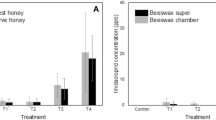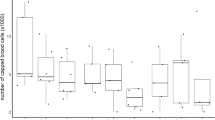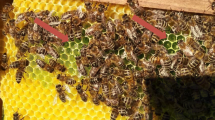Abstract
The first record of tracheal mites, Acarapis woodi, in Japan was made in 2010. These mites have since caused serious damage to the colonies of Japanese honey bees, Apis cerana japonica. In the present study, to control the mites on Japanese honey bees with l-menthol, an agent used for European honey bees, Apis mellifera, we investigated (1) the seasonality of menthol efficacy, (2) the overwintering mortality of menthol-treated colonies, and (3) the menthol residue in honey under field conditions in cooperation with private beekeepers of Japanese honey bees. Seasonal menthol efficacy was tested by applying 30 g of l-menthol for 1 month in different seasons. Mite prevalence was measured by dissecting the honey bee thorax. Overwintering mortality was monitored during winter after checking the mite prevalence in autumn, and was compared with that of untreated colonies reported in our previous study. The residual level of menthol in honey was measured by GC–MS. The results showed that the menthol-treated colonies had a smaller rate of increase in mite prevalence than the untreated colonies. The effects of menthol were highest in March and April. The winter mortality was depressed by menthol treatment. Honey samples extracted from the menthol-treated colonies included 0.4 ppm of menthol residue on average. Our findings suggest that menthol treatment is effective for controlling the tracheal mites on Japanese honey bees.


Similar content being viewed by others
References
Adlakha RL (1976) Acarine disease of adult honey bees in India. Am Bee J 116:344
Bailey L (1958) The epidemiology of the infestation of the honeybee, Apis mellifera L., by the mite Acarapis woodi Rennie and the mortality of infested bees. Parasitology 48:493–506
Bailey L (1961) The natural incidence of Acarapis woodi (Rennie) and the winter mortality of honeybee colonies. Bee World 42:96–100
Bailey L, Lee DC (1959) The effect of infestation with Acarapis woodi (Rennie) on the mortality of honey bees. J Insect Pathol 1:15–24
Clark KJ, Gates NJ (1991) Tracheal mite control trials in British Columbia. Am Bee J 131:773
Committee of Experts on Cosmetic Product (2008) Menthol. In: Committee of Experts on Cosmetic Product (ed) Active ingredients used in cosmetics: safety survey. Council of Europe Pub, Strasbourg, pp 243–264
Cox RL, Moffett JO, Ellis M, Wilson WT (1988) Long-term beneficial effects of menthol treatment on honey bee colonies infested with tracheal mites (Acarapis Woodi). Am Bee J 128:801
Cox RL, Moffett JO, Wilson WT, Ellis M (1989) Effects of late spring and summer menthol treatment on colony strength, honey production and tracheal mite infestation levels. Am Bee J 129:547–549
Delaplane KS (1992) Controlling tracheal mites (Acari: Tarsonemidae) in colonies of honey bees (Hymenoptera: Apidae) with vegetable oil and menthol. J Econ Entmol 85:2118–2124
Ellis MD, Baxendale FP (1997) Toxicity of seven monoterpenoids to tracheal mites (Acari: Tarsonemidae) and their honey bee (Hymenoptera: Apidae) hosts when applied as fumigants. J Econ Entmol 90:1087–1091
Furgala B, Duff S, AbouIfaraj S, Ragsdale D, Hyser R (1989) Some effects of the honey bee tracheal mite (Acarapis woodi Rennie) on non-migratory, wintering honey bee (Apis mellifera L.) colonies in east central Minnesota. Am Bee J 129:195–197
Harrison JF, Camazine S, Marden JH, Kirkton SD, Rozo A, Yang X (2001) Mite not make it home: tracheal mites reduce the safety margin for oxygen delivery of flying honeybees. J Exp Biol 204:805–814
Herbert EWJ, Shimanuki H, Matthenius JCJ (1987) The effect of two candidate compounds on Acarapis woodi in New Jersey. Am Bee J 127:776–778
Herbert EWJ, Shimanuki H, Matthenius JCJ (1988) An evaluation of menthol placement in hives of honey bees for the control of Acarapis woodi. Am Bee J 128:185–187
Joint FAO/WHO Expert Committee on Food Additives (2004) Evaluation of certain food additives. In: W. H. Organization (ed) WHO Technical Report Series 928, p 157
Kamatou GPP, Vermaak I, Viljoen AM, Lawrence BM (2013) Menthol: a simple monoterpene with remarkable biological properties. Phytochemistry 96:15–25
Kojima Y, Toki T, Morimoto T, Yoshiyama M, Kimura K, Kadowaki T (2011) Infestation of Japanese native honey bees by tracheal mite and virus from non-native European honey bees in Japan. Microb Ecol 62:895–906
Lorenzen K, Gary NE (1986) Modified dissection technique for diagnosis of tracheal mites (Acari: Tarsonemidae) in honey bees (Hymenoptera: Apidae). J Econ Entmol 79:1401–1403
Maeda T (2016) Effects of tracheal mite infestation on Japanese honey bee, Apis cerana japonica. J Acarol Soc Jpn 25:105–113
Maeda T, Sakamoto Y (2016) Tracheal mites, Acarapis woodi, greatly increase overwinter mortality in colonies of the Japanese honeybee, Apis cerana japonica. Apidologie. doi:10.1007/s13592-016-0434-x
McMullan JB, Brown MJ (2009) A qualitative model of mortality in honey bee (Apis mellifera) colonies infested with tracheal mites (Acarapis woodi). Exp Appl Acarol 47:225–234
Melathopoulos AP, Winston ML, Whittington R, Smith T, Lindberg C, Mukai A, Moore M (2000) Comparative laboratory toxicity of neem pesticides to honey bees (Hymenoptera: Apidae), their mite parasites Varroa jacobsoni (Acari: Varroidae) and Acarapis woodi (Acari: Tarsonemidae), and brood pathogens Paenibacillus larvae and Ascophaera apis. J Econ Entmol 93:199–209
Moffett JO, Cox RL, Ellis M, Rivera R, Wilson WT, Cardoso-T D, Vargas-C J (1989) Menthol reduces winter populations of tracheal mites, Acarapis woodi, in honey bees from Mexico and Nebraska. Southwest Entomol 14:57–65
Nelson D, Sporns P, Kristiansen P, Mills P, Li M (1993) Effectiveness and residue levels of 3 methods of menthol application to honey bee colonies for the control of tracheal mites. Apidologie 24:549–556
OIE (2008) Chapter 2.2.1. Acarapisosis of honey bees, OIE terrestrial manual 2008. World Organisation for Animal Health, Paris. http://www.oie.int/international-standard-setting/terrestrial-manual/access-online/
Ono M, Igarashi T, Ohno E, Sasaki M (1995) Unusual thermal defence by a honeybee against mass attack by hornets. Nature 377:334–336
Otis GW (1990) Results of a survey on the economic impact of tracheal mites. Am Bee J 130:28–31
Otis GW, Scott-dupree CD (1992) Effects of Acarapis woodi on overwintered colonies of honey bees (Hymenoptera: Apidae) in New York. J Econ Entmol 85:40–46
Rivera R, Wilson WT (1989) Presence and removal of menthol in honey and beewax. Am Bee J 129:821
Sammataro D, Gerson U, Needham G (2000) Parasitic mites of honey bees: life history, implications, and impact. Ann Rev Entomol 45:519–548
Sammataro D, De Guzman L, George S, Ochoa R, Otis G (2013) Standard methods for tracheal mite research. J Apic Res 52:1–20
Sasaki M (1999) Hokugen no Apis cerana. Kaiyusha, Tokyo
Szuho TI, Lefkovitch LP, Clurk KJ (1991) Comparative resistance of honey bees from a closed population to infestation by tracheal mites. Am Bee J 131:643–645
Vecchi MA, Giordani G (1968) Chemotherapy of acarine disease I. Laboratory tests. J Invertebr Pathol 10:390–416
Warrit N, Lekprayoon C (2011) Asian honeybee mites. In: Hepburn HR, Radloff SE (eds) Honeybees of Asia. Springer, Berlin, pp 347–368
Whittington R, Winston ML, Melathopoulos AP, Higo HA (2000) Evaluation of the botanical oils neem, thymol, and canola sprayed to control Varroa jacobsoni Oud. (Acari: Varroidae) and Acarapis woodi (Acari: Tarsonemidae) in colonies of honey bees (Apis mellifera L., Hymenoptera: Apidae). Am Bee J 140:567–572
Wilson WT, Moffett JO, Cox RL, Maki DL, Richardson H, Rivera R (1988) Menthol treatment for Acarapis woodi control in Apis mellifera and the resulting residues in honey. In: Needham GR, Page REJ, Delfinado-Baker M, Bowman CE (eds) Africanized honey bees and bee mites. Ellis Horwood, Chichester, pp 535–540
Wilson WT, Pettis JS, Henderson CE, Morse RA (1997) Tracheal mites. In: Morse RA, Flottum K (eds) Honey bee pests, predators, and diseases, 3rd edn. A. I. Root Company, Medina, pp 255–277
Acknowledgments
We wish to thank the many private beekeepers throughout Japan who provided bee samplings and monitoring surveys. This work was supported by the Sumitomo Foundation and JSPS KAKENHI Grant Number 26290074.
Author information
Authors and Affiliations
Corresponding author
Rights and permissions
About this article
Cite this article
Maeda, T., Sakamoto, Y. Field application of menthol for Japanese honey bees, Apis cerana japonica (Hymenoptera: Apidae), to control tracheal mites, Acarapis woodi (Acari: Tarsonemidae). Exp Appl Acarol 70, 299–308 (2016). https://doi.org/10.1007/s10493-016-0072-z
Received:
Accepted:
Published:
Issue Date:
DOI: https://doi.org/10.1007/s10493-016-0072-z




